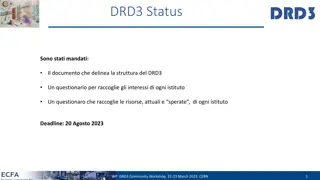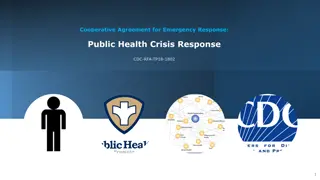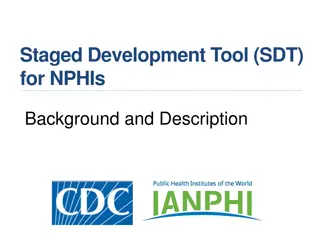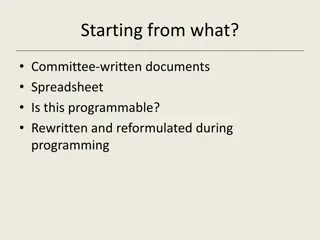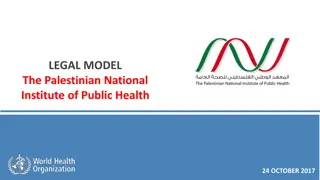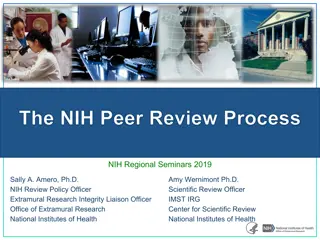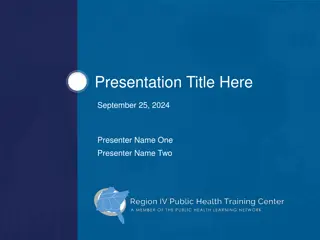Staged Development Tool for National Public Health Institutes
The Staged Development Tool (SDT) is a facilitated self-assessment process designed to assist National Public Health Institutes (NPHIs) in assessing capacities, identifying gaps, and developing actionable plans. It supports planning and prioritization in NPHIs across various countries, including Guinea Bissau, Togo, Colombia, Mongolia, Nigeria, Liberia, Democratic Republic of the Congo, Somalia, Rwanda, South Africa, and Mozambique.
Download Presentation

Please find below an Image/Link to download the presentation.
The content on the website is provided AS IS for your information and personal use only. It may not be sold, licensed, or shared on other websites without obtaining consent from the author.If you encounter any issues during the download, it is possible that the publisher has removed the file from their server.
You are allowed to download the files provided on this website for personal or commercial use, subject to the condition that they are used lawfully. All files are the property of their respective owners.
The content on the website is provided AS IS for your information and personal use only. It may not be sold, licensed, or shared on other websites without obtaining consent from the author.
E N D
Presentation Transcript
I N T E R N A T I O N A LA S S O C I A T I O NO FN A T I O N A LP U B L I CH E A L T HI N S T I T U T E S 2 0 1 8 A N N U A L M E E T I N G | L O N D O N , E N G L A N D Staged Development Tool Updates Shelly Bratton, US CDC
I N T E R N A T I O N A LA S S O C I A T I O NO FN A T I O N A LP U B L I CH E A L T HI N S T I T U T E S 2 0 1 8 A N N U A L M E E T I N G | L O N D O N , E N G L A N D SDT Background The Staged Development Tool (SDT) was developed to support planning in National Public Health Institutes (NPHIs). The SDT is a facilitated self- assessment tool and process that helps NPHIs: assess capacities prioritize gaps that need to be addressed develop concrete plans to address priority gaps SDT implementation at various levels in Guinea Bissau, Togo, Colombia, Mongolia, Nigeria, Liberia, Democratic Republic of the Congo, Somalia, Rwanda, South Africa, and Mozambique
I N T E R N A T I O N A LA S S O C I A T I O NO FN A T I O N A LP U B L I CH E A L T HI N S T I T U T E S 2 0 1 8 A N N U A L M E E T I N G | L O N D O N , E N G L A N D SDT implementation internal facing Formal use of SDT Infomal use of SDT SDT Domains Internal-Facing Discussion Guides 1. Planning 2. Leadership and Management 3. Health and Safety 4. Laboratory Safety 5. Human Resources Management 6. Staff Development 7. Management of Organizational Information 8. Internal Communication 9. External Communication about NPHI & Activities 10. Information Technology 11. Financial Management External-Facing Discussion Guides 12. Population Health Status 13. Management of Public Health Information 14. Health Communication 15. Laboratory Reference & Diagnostic Services/Quality 16. Surveillance 17. Surveillance for Acute Public Health Problems 18. Sentinel Surveillance 19. Reporting of Acute Public Health Events 20. Investigation of Acute Public Health Events 21. Emergency Preparedness and Response 22. Implementation of International Health Regulations 23. Data-to-Action 24. Strategic Data Collection and Analysis 25. Development of Public Health Recommendations 26. Uptake of Public Health Recommendations 27. Public Health Workforce Development 28. Public Health Research GNB TGO COL MNG NGA LBR DRC Internal-Facing Discussion Guides SOM RWA ZAF MOZ x x x x x x x x x x x x x x External-Facing Discussion Guides x x x x x x x x x x x x x x x x x x x x x x x x x x x x x x x x x x x x
Formal use of SDT Infomal use of SDT SDT Domains Internal-Facing Discussion Guides 1. Planning 2. Leadership and Management 3. Health and Safety 4. Laboratory Safety 5. Human Resources Management 6. Staff Development GNB TGO COL MNG NGA LBR DRC Internal-Facing Discussion Guides SOM RWA ZAF MOZ x x x x x x x I N T E R N A T I O N A LA S S O C I A T I O NO FN A T I O N A LP U B L I CH E A L T HI N S T I T U T E S 7. Management of Organizational Information 8. Internal Communication 9. External Communication about NPHI & Activities 10. Information Technology 11. Financial Management External-Facing Discussion Guides 12. Population Health Status 13. Management of Public Health Information 14. Health Communication 15. Laboratory Reference & Diagnostic Services/Quality 16. Surveillance 17. Surveillance for Acute Public Health Problems 18. Sentinel Surveillance 19. Reporting of Acute Public Health Events 20. Investigation of Acute Public Health Events 21. Emergency Preparedness and Response 22. Implementation of International Health Regulations 23. Data-to-Action 24. Strategic Data Collection and Analysis 25. Development of Public Health Recommendations 26. Uptake of Public Health Recommendations 27. Public Health Workforce Development 28. Public Health Research x x 2 0 1 8 A N N U A L M E E T I N G | L O N D O N , E N G L A N D SDT implementation external facing x x x x x External-Facing Discussion Guides x x x x x x x x x x x x x x x x x x x x x x x x x x x x x x x x x x x x
I N T E R N A T I O N A LA S S O C I A T I O NO FN A T I O N A LP U B L I CH E A L T HI N S T I T U T E S 2 0 1 8 A N N U A L M E E T I N G | L O N D O N , E N G L A N D SDT facilitators training April 2018 in Johannesburg, South Africa 23 facilitators trained from all regions of the world including African participants from: Ethiopia, Guinea-Bissau, Mozambique, Nigeria, South Africa, Uganda, Africa CDC, WHO/AFRO Trained facilitator supported SDT implementation in DRC in September











